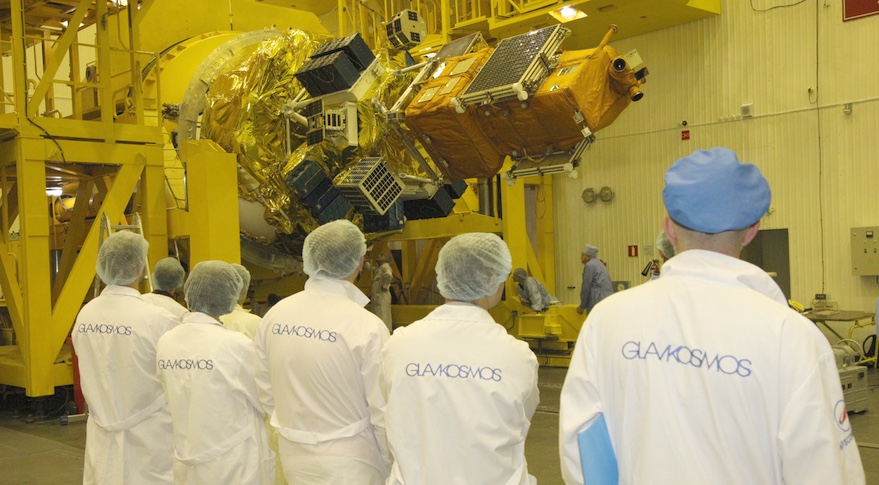Russian Soyuz Rocket Set to Launch 72 Smallsats Friday

WASHINGTON — A Soyuz launch scheduled for July 14 will carry more than 70 small satellites, including spacecraft for four separate commercial remote sensing and weather constellations.
The 72 smallsats flying on the Soyuz launch scheduled for the morning of July 14 from the Baikonur Cosmodrome in Kazakhstan will fly as secondary payloads, with the Kanopus-V-IK remote sensing satellite serving as the primary payload.
The satellites have all been integrated with the Fregat's upper stage, and launch preparations remain on track. "Everything looks good," said Vsevolod Kryukovskiy, launch program director at Glavkosmos, in a July 7 interview. "We've finalized everything and are on schedule."
Glavkosmos, a subsidiary of Russian state space corporation Roscosmos, is seeking to become a larger provider of rideshare launch services for small satellites. In addition to this upcoming launch, Glavkosmos is planning to fly about 40 more small satellites on two Soyuz missions from the new Vostochny Cosmodrome in Russia's Far East region late this year, with additional launch opportunities planned for 2018 and beyond.
The biggest single customer for the upcoming launch is Planet, the San Francisco-based company that operates the world's largest constellation of imaging satellites. Planet will fly 48 of its Dove cubesats on this mission, which the company says will complete its initial fleet of spacecraft.
"This rounds out what we would call 'Mission One,'" Mike Safyan, director of launch at Planet, said in a July 6 interview. If successful, the 48 Dove satellites on this launch will bring the company's total number of operational satellites to 190, counting five RapidEye satellites and the seven SkySat satellites from Terra Bella, which Planet acquired from Google earlier this year.
This "flock" of 48 satellites will go into a sun-synchronous orbit, but one slightly different from those of 88 similar satellites launched on an Indian Polar Satellite Launch Vehicle in February. Those satellites went into a sun-synchronous orbit that crosses the equator at 9:30 a.m. local time. The new satellites will launch into an orbit that crosses the equator at about 11 a.m. local time.
Get the Space.com Newsletter
Breaking space news, the latest updates on rocket launches, skywatching events and more!
"That allows for some interesting capabilities," Safyan said, such as the ability to observe the same location twice in a single day. "To have multiple looks in a single day at this scale and this coverage and this frequency is something that is going to be unique to Planet."
Safyan said that the major wave of Planet cubesats won't come until late 2018 or early 2019. "With this launch, we have the Mission One fleet in place and operating, so that then gives us time to start planning for the replenishment," he said.
Three other companies developing smallsat constellations are also flying satellites on this launch. Spire, which is deploying a fleet of cubesats to collect GPS radio occultation and ship tracking data, has eight of its Lemur cubesats on this launch.
Spire has made extensive use of rideshare opportunities on Indian and Russian rockets to deploy its constellation. "There's no other reason, beyond opportunity, that we're seeking foreign rideshares," Jenny Barna, launch manager at Spire, said at a rideshare workshop last month. "It's really just about opportunity, and it doesn't exist in the U.S."
In addition to the 48 Doves and 8 Leumrs, the Soyuz will be carrying satellite for two other companies with plans for small satellite constellations. GeoOptics is flying its first three CICERO cubesats, designed to collect GPS radio occultation data to support weather forecasting. Astro Digital is flying its first two Corvus-BC medium-resolution imaging cubesats.
The remaining secondary payloads are a mix of technology demonstration cubesats and other small satellites from several countries, including Canada, Germany, Japan, Norway, Russia and the United States. The one U.S. cubesat in that group is NanoACE, built by Tyvak Nano-Satellite Systems to test attitude control and propulsion technologies.
Other satellites in that group include three cubesats built by Russian universities and two imaging cubesats built by Dauria Aerospace for Roscosmos.
This story was provided by SpaceNews, dedicated to covering all aspects of the space industry.
Join our Space Forums to keep talking space on the latest missions, night sky and more! And if you have a news tip, correction or comment, let us know at: community@space.com.

Jeff Foust is a Senior Staff Writer at SpaceNews, a space industry news magazine and website, where he writes about space policy, commercial spaceflight and other aerospace industry topics. Jeff has a Ph.D. in planetary sciences from the Massachusetts Institute of Technology and earned a bachelor's degree in geophysics and planetary science from the California Institute of Technology. You can see Jeff's latest projects by following him on Twitter.










